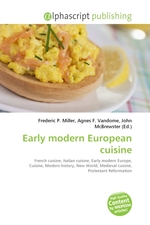Early modern European cuisine
Frederic P. Miller, Agnes F. Vandome, John McBrewster
бумажная книга
The cuisine of early modern Europe was a mix of dishes inherited from medieval cuisine combined with innovations that would persist in the modern era. There was a great influx of new ideas, an increase in foreign trade, religious reformation and a scientific revolution. The discovery of the New World, the establishment of new trade routes with Asia and increased foreign influences from sub-Saharan Africa and the Middle East meant that Europeans became familiarized with a multitude of new foodstuffs. Spices that previously had been prohibitively expensive luxuries soon became available to the majority population, and the introduction of new plants like maize, potato, sweet potato, chili pepper, cocoa, vanilla, tomato, coffee and tea transformed European cuisine forever. There was a very great increase in prosperity in Europe during this period, which gradually reached all classes and all areas, and considerably changed the patterns of eating. Nationalism was first conceived in the early modern period, but it was not until the 19th century that the notion of a national cuisine emerged. Class differences were far more important dividing lines, and it was almost always upper-class food that was described in recipe collections and cookbooks
Данное издание не является оригинальным. Книга печатается по технологии принт-он-деманд после получения заказа.


